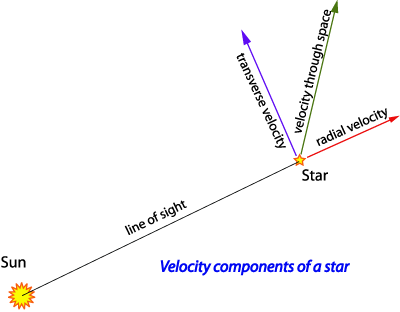Stellar Motions (Extension)
In 1718 in Philosophical Transactions Edmond Halley noted that the bright stars Sirius, Aldebaran and Arcturus had changed their positions relative to other stars since antiquity. This was the first recorded mention of proper motion, the shift of a star's (or other celestial object's) position across the celestial sphere. Proper motion is measured in units of arcseconds per year, ("/yr).
Stars are in constant motion, some are moving towards us and some away. Galaxies too exhibit random motions so that some in the nearby group are moving towards us relatively. On larger scales most galaxies are receding from us due to the expansion of space as observed by Edwin Hubble. Our Sun orbits the centre of the Milky Way at 220 km/s. A star's actual velocity through space relative to our Sun is impossible to measure directly. Instead astronomers have to measure two components of it, the transverse velocity and the radial velocity.
The transverse (or tangential) velocity of an object is its motion across our line of sight as it appears on the celestial sphere. A star's proper motion depends on its actual transverse velocity and inversely with its distance from us. This means that if two objects have the same absolute transverse velocity, the closer one will exhibit a higher proper motion, just a s a car speeding past you on the road apparently moves faster than a passenger jet at high altitude even though the jet is actually moving faster.
The radial velocity of object is how fast it is moving towards or away from us along our line of sight. This is measured by measuring the doppler shift of spectral lines in that object's spectrum. Objects moving towards us will have their lines blue-shifted, those moving away will be red-shifted.
Theoretically one could obtain a star's proper motion simply by making two observations of its position one year apart (to remove any effect of parallax) and see if it had moved relative to other stars. In practice as the proper motion is very small, it is often only measurable by comparing observations taken a few decades or more apart. This is one valuable application of repeated sky surveys. Corrections are also made for the earth's motion around the Sun so that proper motions are always expressed relative to the Sun, not the Earth.
The highest proper motion of any star is that of the nearby Barnard's Star with a value of 10.3"/yr. It has a radial velocity of 108 km/s towards us and a transverse velocity of 88 km/s. This means it is moving closer to us and will be at its closest in 12,000 A.D.

